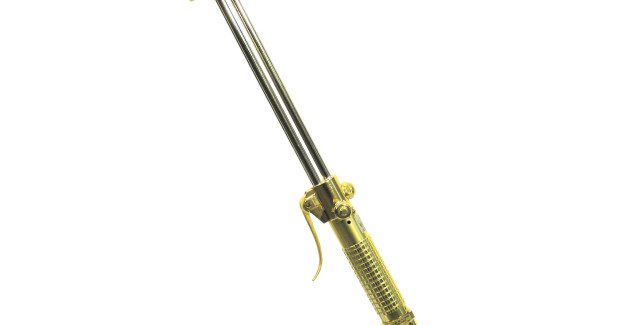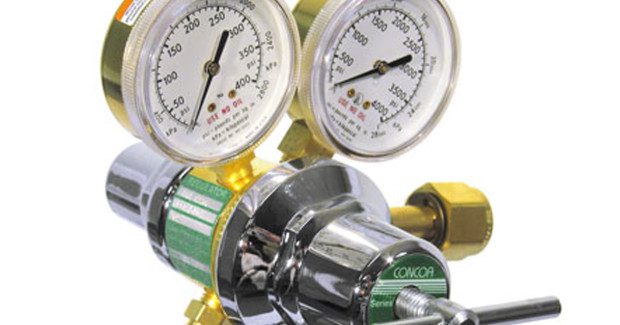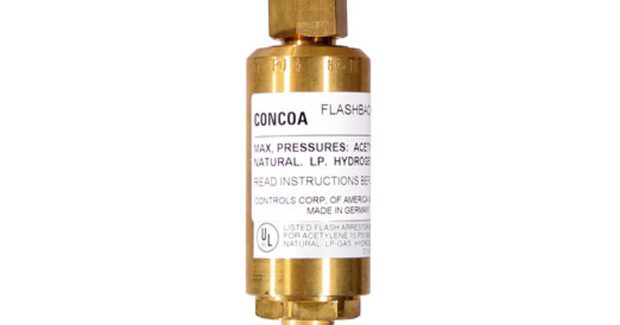Safeguarding the Shop: Piping Job Shops for Oxy-fuel Efficiency, Safety and Performance
Ensuring optimal oxy-fuel operations safety and performance is dependent on proper equipment selection and adherence to sound practices.
Posted: May 1, 2015
Everyone who uses oxy-fuel equipment should be trained prior to working with torches, regulators, or heating equipment of any kind. Many shops have refresher “training” sessions to make sure that safe operation of welding and cutting equipment continues as employees mature in their positions. Fortunately, the evolution of safe and reliable equipment in the fields of oxy-fuel cutting, welding, and heating, which is based on years of industry experience, exists today. Unfortunately, not everyone subscribes to common sense when it comes to the day-to-day usage of oxy-fuel torches, regulators and manifolds. Basic maintenance and leak-checking of the equipment must be done daily to mitigate the potential for personal injury, property damage, or death.
With any oxy-fuel application, the work environment and conditions must be taken into consideration prior to selecting cutting, welding, and heating equipment. Most all equipment that is available is identified as light-, medium- or heavy-duty in construction. If you use the equipment every day and are working with thick gauge steel that requires high pressures and flows, heavy-duty equipment is recommended. If you are a hobbyist or occasional user, light- or medium-duty equipment would be more appropriate. Ensuring optimal safety and performance is dependent on proper equipment selection and adherence to sound practices, as outlined here.
TORCH SELECTION
The safest cutting torch design available is a tip-mix torch in which the oxygen and fuel gas are mixed right at the tip. If there is a problem with the mix, a new tip can be installed to correct the problem. Also, if the fuel gas is changed, all that needs to be done is to change the cutting tip. There are tube-mix torches available in which the oxygen and fuel gas are mixed in a chamber between the handle and the head of the torch. The downside of this design is that if there is a problem with the mixer, the torch would need to be taken out of service and sent out for repair. On a tube-mix designed torch, the mixers are fuel-gas specific, so if the operator changes fuel gas, the torch would need to be sent out and the mixer modified for the new fuel gas.
There are basically two types of cutting torches available in the market today: straight-cutting and combination torches. A straight-cutting torch as shown in Figure 1 is just for cutting, and is constructed of one piece, whereas a combination torch consists of a handle and a detachable cutting attachment. The handle can also be used with welding and heating tips. When cutting thick steel or cutting steel in a corner or an area that has material on either side of the cut, the heat of the cutting process can be reflected back at the torch head. A stainless steel head on the cutting torch or attachment is recommended here because it will stand up to the reflected heat and elevated temperatures better than bronze and provide longer service life.
REGULATOR SELECTION
Regulators come in two types, single-stage or two-stage design, as shown in Figures 2 and 3. The outlet pressure from a single-stage regulator will increase as the source pressure decreases, which is known as the decaying-inlet pressure characteristic. As the cutting process continues, the operator would need to readjust the delivery pressure set point on the single-stage regulator as the cylinder pressure decreases. A single-stage regulator is most common in oxy-fuel applications because most torch operations are not very long in duration. With a dual stage regulator, as the inlet pressure decreases the outlet pressure remains stable. If the application is an extended cutting operation, a two-stage regulators is recommended.
PROPER SETUP
On a practical level, accidents typically occur when equipment is improperly installed, maintained, or used. Most safe practices are based on common sense. Everything starts at the product source, and knowing the correct gas for the application is essential.
Gas cylinders should always be fastened securely to a wall, stand, or cart to keep from being knocked over. The fasteners must be of a nonflammable material, and in some states, two sets of restraining straps are required on each cylinder. California, for example, requires double restraining straps because of earthquakes. With compressed gas cylinders except for those filled with fuel gases, before attaching the regulator or manifold pigtail to the cylinder valve, turn the valve away from you, open it slightly and then close it. This helps to remove loose dirt and contamination that could get into the regulator or inlet fitting and compromise its performance. Depending on the area in which you work, it’s not uncommon to find things like spider webs or hornet nests inside cylinder caps and in cylinder valves. Allowing this contamination to enter a regulator can cause premature seat failure.
The cylinder valve opening and the regulator inlet nipple should always be shiny and clean inside and out. This is particularly important in oxygen service. Oil, grease or any hydrocarbon (WD-40) in the presence of pure oxygen is flammable and/or explosive. Always keep a pure oxygen source away from oil, grease, hydrocarbons, or other flammable substances. After installing the regulator to the cylinder, but before opening the cylinder valve, make sure the adjusting knob or “T” handle on the regulator is in the “off” position, or backed out in the counter-clockwise position. The cylinder valve should be rotated slowly to the “on” position to prevent damaging the regulator from adiabatic compression (heat of recompression ignition). It’s also a good idea never to stand in front of or to the side of a regulator when opening the cylinder valve. Always stand where the cylinder is between you and the regulator.
Once the inlet gauge reading stops rising, open the oxygen cylinder valve all the way. Most fuel gas cylinders should only be opened 1 to 1-1/2 turns and preferably no more than 3/4 of a turn. The advantage of this is to be able to shut off the fuel gas source in case of an emergency.
FLASHBACK ARRESTORS
Using a cutting tip with an incorrect tip size can result in a flashback. Correctly located flashback arrestors in the gas delivery system, as shown in Figure 4, are critical. Never use oxy-fuel regulators or torches without flashback arrestor protection. Flashback arrestors come in cylinder, torch, and line versions depending, on where they need to be located, and most incorporate a check valve in the design. It is recommended to have both oxygen and fuel gas arrestors in place to properly protect the operator.
HOSES
The twin line, red-green oxy-fuel hoses are one of the least expensive but often the most overlooked component in a welding or cutting application. Correct hose material is required for different fuel gases; one hose does not fit all applications. A quick test to check and see if your hose needs to be replaced is to take the twin hose in hand and double it back on itself, creating a “pinch.” If there is any sign of cracking, thinning or wear, discard the hose and replace it with a new one.
Never repair a hose with tape and avoid splicing. Always use the shortest possible length of hose. Not only is there more explosive oxy-fuel available for a potential accident should a hot piece of slag drop and burn through the hose, but the extra length will also create pressure-drop at the torch. When extended lengths of hose are required, test gauges are available to help set the tip pressures correctly through this line-loss dynamic. There are several grades of twin hose available depending on your choice of fuel gas. Be sure you are using the correct grade of hose for your application.
DAILY SAFETY CHECKS
In the case of oxygen and fuel gas cylinders, it helps to compare them to a missile and a bomb. Oxygen cylinders are normally filled to 2,000-2,500 psi and if the cylinder were to fall and the valve on the cylinder broken off, the cylinder would take off like a missile and could cause serious injury or death. Fuel gas cylinders contain liquefied flammable product that is just waiting for an ignition source. The best approach is to leak-check every fitting and connection to eliminate leaks prior to using the equipment. Its highly recommend to use a spray bottle of oxygen-safe leak check before starting the cutting, welding or heating process. The National Fire Protection Association (NFPA) requires that visual and bubble-leak testing be performed on oxy-fuel cutting and welding torch setups prior to every use.
CORRECT OPERATION OF TORCHES FOR SAFETY
After making sure that the above recommendations have been followed, the next step is to set up the torch for the cutting application. This requires knowing the oxygen and fuel gas pressure set points and the flow required to the torch for safe operation. Contact your distributor or the equipment manufacturer for a copy of the appropriate tip chart to ensure the proper pressure and flow settings are used.
Since most oxy-fuel cuts are short in duration, most oxygen cylinders can keep up with a typical cutting process. The scenario you want to avoid is running out of product during the cut. This can cause a flashback or burn back condition as the oxygen cylinder empties and can no longer keep up with the pressure and flow required. You wouldn’t start a long drive with an almost-empty gas tank. Likewise, don’t start an oxy-fuel process with an almost-empty oxygen cylinder. In the case of acetylene, a good rule is to never extract more than 10 percent of the cylinder’s rated volume, which means, for example, that if the cylinder is filled to 132 C/F, the highest flow that could be safely extracted is 13.2 scfh. If the tip being used requires more flow, a larger cylinder would be required or multiple cylinders must be combined to feed the application. With fuel gases being in a liquid state going to vapor inside the cylinder, it is difficult to know when a fuel gas cylinder is close to being empty. Always keep an eye on the inlet source gauge to make sure you won’t run out of product in the middle of a cut.
The same rules of torch safety apply to heating or rosebud applications. The critical issue here is to supply the heating head with enough fuel gas. All fuel gases that come from liquid product have a vapor rate that is affected by temperature and wetted surface area inside the cylinder. Using a heating head with a fuel gas cylinder half full or almost empty or in cold temperatures will affect its performance. The flame on a heating head must always be off the end of the tip. To make that happen requires adequate pressure and flow to the equipment. No small or medium size fuel gas cylinders can be used to supply the process. In most cases multiple fuel gas cylinder are required to be manifolded together to keep up with the flow demand of the heating head.
PERSONAL PROTECTION EQUIPMENT
In shop environments in which cutting, welding and heating of metals are performed, protecting yourself from hot metal and slag from a cut is essential. Flame- retardant gloves, jackets, shoe covers and leather clothing are available to keep embers from setting the operator on fire. There are many product options for eye and face protection. Welding helmets come in a variety of shapes, styles and colors, some with auto-darkening lenses. Goggles and face shields are another way of keeping yourself safe in a welding and burning environment. It is good rule to always inspect the work area prior to lighting the torch. A spark or ember from a cutting application can travel 30 ft in a shop. Ensure there are no flammable items in the work area, and always have an approved fire extinguisher available in case of a fire
CYLINDER STORAGE
NFPA recommends locating all oxidizers or oxygen cylinders a minimum of 25 ft from flammable or combustible items or conditions, and to isolate them in a way to keep them from being tampered with by unauthorized personnel. Electrical outlets and potential must also be isolated by 25 ft when flammable gases are stored in the same area. An oxygen cylinder must never be stored with flammable gas cylinders. A minimum of 25 ft or an eight-hour rated firewall is required between these two products for safe storage.
ADVANTAGES OF PIPING A SHOP
Placing oxy-fuel cylinders on a cart are the most common way to set up a welding or cutting work station. When that one application evolves into multiple work stations, however, or the application requires more pressure and/or flow than a set of cylinders can produce, it will need to be upgraded to ensure efficiency and performance. True, every use point could be outfitted with a cylinder and pressure-reducing regulator, or in the case of higher consumption, you could keep going out and manually changing cylinders as required, but this approach is time-consuming and costly. By installing the cylinders at one main location, and controlling them with a basic manifold or switchover manifold, however, the operator won’t be interrupted by a cylinder’s running out of gas. A good option is to have the gas supplier or a maintenance employee change out the empty cylinders so as not to interrupt the welding or cutting process.
WHEN PIPING IS COST-EFFECTIVE
Industry standards tell us it takes an average of 20-30 minutes to change out an empty gas cylinder with a full one, which translates into a regular interruption that creates loss in productivity. When multiplied by the number of work stations in a shop, it adds up to considerable lost time. The other unseen cost is cylinder rental at $0.25-$0.40 cents a day per cylinder on high-pressure cylinders and $1.50-$3.00 per day on liquid cylinders. Improved efficiency and cost reduction can be achieved by installing a piping system that connects to a cylinder manifold, switchover system, or bulk tank. The key here is to size the piping and gas delivery system for the total combined pressure and flow required at all the use points. This must be done to prevent “starving” any of the downstream use points. When sizing the piping system, it is important to use the correct size pipe or tube to ensure the gas pressure and flow will not be restricted.
Additionally, considerations for future expansion of the piping system should be discussed before the size of the piping is selected. Since the difference in cost of materials is minimal, it’s a good idea to err on the side of caution and use a larger size pipe or tube. There are two types of piping systems, dead-end or looped. With a dead-end system, the piping system starts at the cylinder manifold and ends at the last drop or use point. With a looped system, there will be two ways the gas can travel to the last use point. By using the correct size pipe and by looping the gas piping system, you can ensure that none of the use points will be affected if there is a large flow demand at one location.
Sometimes a mode change is the next step in efficiency. Since the gas product is at a premium in high pressure cylinders, the best way to lower your costs would be to use a vertical gas liquid (VGL) or liquid cylinder. Liquid cylinders are essentially big thermos bottles capable of delivering gas or liquid product to an application. They are commonly available in oxygen, nitrogen, argon and carbon dioxide service. One liquid cylinder’s volume is equal to approximately 15 to 20 high-pressure cylinders, and it costs much less to fill one liquid cylinder than it does to fill 20 high-pressure cylinders.
Liquid cylinders have a gas-use port, liquid-use port, and vent- connection port on the top. A pressure-building circuit generates additional pressure and flow to the application, and an economizer circuit keeps it from generating gas when demand is low. Safety relief valves set at 230 psi, 350 psi or 500 psi are installed on the liquid cylinder to ensure internal pressures will never reach the point where the cylinder could rupture or explode. With standard liquid argon, nitrogen and oxygen cylinders, the pressure-building capacity is normally around 300 scfh, with peak flow of 350 scfh for short periods. With standard liquid carbon dioxide cylinders, the pressure building capacity is typically around 100 scfh, with peak flow of 150 scfh for short periods of time.
If the application demands more flow then one cylinder can provide, additional cylinders can be manifolded to supply the application.




















